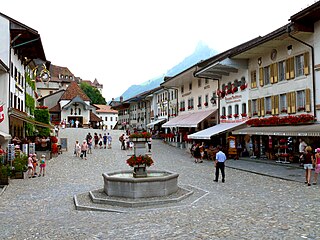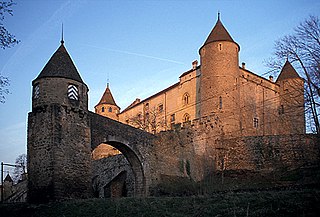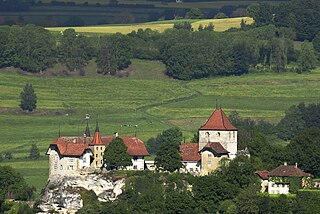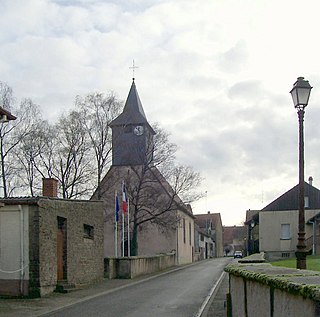| Rue Castle | |
|---|---|
| Rue | |
 Rue Castle | |
| Coordinates | 46°37′12″N6°49′21″E / 46.619994°N 6.822431°E |
| Code | CH-FR |
Rue Castle is a castle in the municipality of Rue of the Canton of Fribourg in Switzerland. It is a Swiss heritage site of national significance. [1]
| Rue Castle | |
|---|---|
| Rue | |
 Rue Castle | |
| Coordinates | 46°37′12″N6°49′21″E / 46.619994°N 6.822431°E |
| Code | CH-FR |
Rue Castle is a castle in the municipality of Rue of the Canton of Fribourg in Switzerland. It is a Swiss heritage site of national significance. [1]

Geneva is the second-most populous city in Switzerland and the most populous in French-speaking Romandy. Situated in the southwest of the country, where the Rhône exits Lake Geneva, it is the capital of the Republic and Canton of Geneva, and a centre for international diplomacy. Geneva hosts the highest number of international organizations in the world.

Gruyères is a town in the district of Gruyère in the canton of Fribourg, Switzerland.

Neuchâtel is a town, a municipality, and the capital of the Swiss canton of Neuchâtel on Lake Neuchâtel. Since the fusion in 2021 of the municipalities of Neuchâtel, Corcelles-Cormondrèche, Peseux, and Valangin, the city has approximately 33,000 inhabitants. The city is sometimes referred to historically by the German name Neuenburg; both the French and German names mean "New Castle".

The Tuileries Palace was a royal and imperial palace in Paris which stood on the right bank of the Seine, directly in the west-front of the Louvre Palace. It was the Parisian residence of most French monarchs, from Henry IV to Napoleon III, until it was burned by the Paris Commune in 1871.

Morges is a municipality in the Swiss canton of Vaud and the seat of the district of Morges. It is located on Lake Geneva, west of Lausanne.

Grandson is a municipality in the district of Jura-Nord Vaudois in the canton of Vaud in Switzerland. It is situated on the south-west tip of Lake Neuchâtel, about 25 km north of Lausanne. It was part of the Kingdom of Upper Burgundy until the death of Rudolph III of Burgundy (993-1032), also King of Lower Burgundy, the last in the male line, when it was united with the Holy Roman Empire. On 2 March 1476, during the Burgundian Wars, Charles the Bold was defeated here in the Battle of Grandson.

La Chaux-de-Fonds is a Swiss city in the canton of Neuchâtel. It is located in the Jura Mountains at an altitude of 992 metres, a few kilometres south of the French border. After Geneva, Lausanne, Bienne, and Fribourg, it is the fifth-largest city in the Romandie, the French-speaking part of the country, with a population of 36,915.

"Un banc, un arbre, une rue" is a song recorded by French singer Séverine, with music composed by Jean-Pierre Bourtayre and French lyrics written by Yves Dessca. It represented Monaco in the Eurovision Song Contest 1971 held in Dublin, resulting in the country's only ever win in the contest.

Rue is a municipality in the district of Glâne in the canton of Fribourg in Switzerland. On 1 January 1993 the former municipality of Blessens merged into Rue, followed by Promasens and Gillarens in 2001.

Alteckendorf is a commune in the Bas-Rhin department in the Grand Est region of northeastern France.

Altwiller is a commune in the Bas-Rhin department in the Grand Est region of northeastern France.

Achery is a commune in the department of Aisne in the Hauts-de-France region of northern France.

13th Street is a television channel specializing in action, suspense and police procedural programs and movies, mainly from the Universal Pictures and Television libraries. It is owned by NBCUniversal and was inaugurated in France in 1997, quickly adding local versions across Europe and Australia.
Bellegarde-en-Marche is a commune in the Creuse department in the Nouvelle-Aquitaine region in central France.

Saint-Sauveur-en-Rue is a commune in the Loire department in central France.

Vatteville-la-Rue is a commune in the Seine-Maritime department in the Normandy region in northern France.

Ville is a commune in the Oise department in the region of Hauts-de-France in northern France. The village is divided into a northern part and a southern part by the river Divette.

Waldegg Castle, or Schloss Waldegg, is a castle near Solothurn, in the municipality of Feldbrunnen-St. Niklaus of the Canton of Solothurn in Switzerland. It is a Swiss heritage site of national significance.

Argentat-sur-Dordogne is a commune in the department of Corrèze, south-central France. The municipality was established on 1 January 2017 by merger of the former communes of Argentat and Saint-Bazile-de-la-Roche.